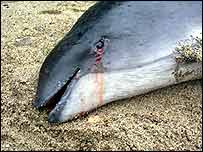|
"Dolphins use sonar to hunt and avoid obstacles, even in the dark. Yet despite this sophisticated navigation system, thousands die each year when they become entangled in fishing nets.
"In my own region, over 200 dolphins and porpoises were found dead around the coast in Devon and Cornwall between January and March this year. That's averaging two a day."
Many of these fatalities are thought to have been caused by trawl nets, often towed by pairs of boats.
The European fisheries commissioner, Franz Fischler, who is proposing the new rules, is well aware they will be strongly contested by some member states.
Up to a point
His office says that because of "the high political sensitivity of the cetacean bycatch problem, this proposal will certainly lead to intensive debate in [the Fisheries] Council and European Parliament."
Mark Simmonds, of the Whale and Dolphin Conservation Society (WDCS), told BBC News Online: "The involvement of the European Commission in this problem is very good.
" But it would be wrong to think the pingers are going to be silver bullets. They work on some nets, but not all.
"And with them there's a danger of turning parts of the sea into dolphin exclusion zones, just fish production areas.
"But anything that takes us in the direction of observers on boats must be right, and we welcome that."
Top
|

